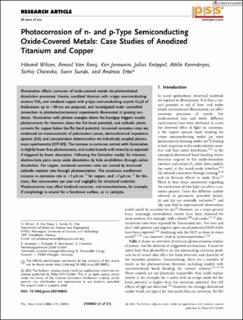| dc.contributor.author | Wilson, Håvard | |
| dc.contributor.author | Van Rooij, Arnoul | |
| dc.contributor.author | Jenewein, Ken | |
| dc.contributor.author | Knöppel, Julius | |
| dc.contributor.author | Kormányos, Attila | |
| dc.contributor.author | Cherevko, Serhiy | |
| dc.contributor.author | Sunde, Svein | |
| dc.contributor.author | Erbe, Andreas | |
| dc.date.accessioned | 2022-11-08T09:48:31Z | |
| dc.date.available | 2022-11-08T09:48:31Z | |
| dc.date.created | 2022-04-29T18:42:13Z | |
| dc.date.issued | 2022 | |
| dc.identifier.citation | Physica Status Solidi (a) applications and materials science. 2022, . | en_US |
| dc.identifier.issn | 1862-6300 | |
| dc.identifier.uri | https://hdl.handle.net/11250/3030588 | |
| dc.description.abstract | Illumination affects corrosion of oxide-covered metals via photoinitiated dissolution processes. Herein, anodized titanium with n-type semiconducting anatase TiO2 and anodized copper with p-type semiconducting cuprite Cu2O of thicknesses up to ≈90 nm are prepared, and investigated under controlled convection in photoelectrochemical experiments illuminated at grazing incidence. Illumination with photon energies above the bandgap triggers anodic photocurrents for titanium above the flat band potential, and cathodic photocurrents for copper below the flat band potential. Increased corrosion rates are evidenced via measurements of polarization curves, electrochemical impedance spectra (EIS) and concentration determination via inductively coupled plasma mass spectrometry (ICP-MS). The increase in corrosion current with illumination is slightly lower than photocurrents, and scales linearly with intensity as expected if triggered by linear absorption. Following the Gerischer model, for titanium, electron-hole pairs cause oxide dissolution by hole annihilation through cation dissolution. For copper, increased corrosion rates are caused by increased cathodic reaction rate through photoexcitation. The maximum nonthermal increase in corrosion rate is ≈1 μA cm−2 for copper, and ≈7 μA cm−2 for titanium, few micrometers per year and negligible for structural materials. Photocorrosion may affect localized corrosion, and nanostructures, for example, if morphology is crucial for a functional surface, as in catalysts. | en_US |
| dc.language.iso | eng | en_US |
| dc.publisher | Wiley | en_US |
| dc.rights | Navngivelse 4.0 Internasjonal | * |
| dc.rights.uri | http://creativecommons.org/licenses/by/4.0/deed.no | * |
| dc.title | Photocorrosion of n- and p-Type Semiconducting Oxide-Covered Metals: Case Studies of Anodized Titanium and Copper | en_US |
| dc.title.alternative | Photocorrosion of n- and p-Type Semiconducting Oxide-Covered Metals: Case Studies of Anodized Titanium and Copper | en_US |
| dc.type | Peer reviewed | en_US |
| dc.type | Journal article | en_US |
| dc.description.version | publishedVersion | en_US |
| dc.source.pagenumber | 21 | en_US |
| dc.source.journal | Physica Status Solidi (a) applications and materials science | en_US |
| dc.identifier.doi | 10.1002/pssa.202100852 | |
| dc.identifier.cristin | 2020233 | |
| cristin.ispublished | true | |
| cristin.fulltext | original | |
| cristin.qualitycode | 1 | |

